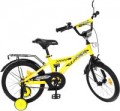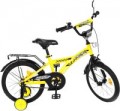Max. weight
The maximum rider weight that the bike can normally carry. This point is directly related to the age group (see above), however, bikes with the same age recommendations may differ in maximum load.
Of course, it is impossible to exceed the load specified by the manufacturer: even if an accident does not happen immediately, it can happen at any time. And ideally, you should choose a bike with a margin of weight — both in case of emergency situations, and taking into account the fact that the child will grow.
Frame material
—
Steel. A fairly common material, widely used in all types of children's bicycles (see "Type"). Although inexpensive, steel is very durable, reliable, and resistant to impacts and shocks. Many consider its main drawback to be its relatively large weight; however, the difference in weight with the same aluminum is usually not that great (especially compared to the weight of the cyclist). It is worth noting that different grades of steel can be used in children's bicycles, and the overall quality of this material often depends on the price category of the machine.
—
Aluminum. Aluminum-based alloys are very strong, weigh little, and are also much less susceptible to corrosion than steel. On the other hand, the cost of such materials is significantly higher, and high strength is not always critical (considering the peculiarities of riding children's bicycles, especially three-wheeled ones). Therefore, aluminum is less common, although it can also be used in all types of machines.
—
Plastic. Plastic is relatively light in weight, completely insensitive to moisture and easy to process — it can be given almost any shape and color. At the same time, this material is inexpensive. On the other hand, plastic is not durable; therefore, it is used exclusively in bicycles for the smallest, mainly in three-wheeled models and balance bikes (see "Type").
—
...href="/list/604/pr-9552/">Wood. The general characteristics of wood are such that this material is poorly suited for classic bicycles — both two- and three-wheeled — but is very convenient for balance bikes (see "Type"). Wood, even unpainted, looks good, and this material is quite pleasant to the touch. Its disadvantages include some fragility — while the same plastic is likely to bend from a strong impact, wood can crack. However, it is still difficult to damage a wooden balance bike frame. But such a product does not tolerate moisture well, so it should be stored in a dry place.
— Fiberglass. As a rule, in this case it is not pure fiberglass that is meant, but fiberglass — a composite material made of glass fiber filled with plastic filler. This material is noticeably stronger than regular plastic, but it is also more expensive, and in terms of overall reliability it still does not reach the level of steel and aluminum. Therefore, fiberglass frames are quite rare, and mainly among balance bikes (see "Type").
— Magnesium. Magnesium alloys are similar to the aluminum alloys described above: they are highly durable and lightweight. At the same time, compared to aluminum, this alloy is stronger and more durable, weighs more, but not much, but costs significantly more — and the difference in price rarely outweighs the advantages mentioned. As a result, magnesium frames are not very widespread; they are found only in certain models of two-wheeled bicycles of the older age group.Wheel diameter
Bicycle wheel diameter is traditionally indicated in ". The overall height of the bike directly depends on this parameter, so each age category has its own wheel size - in accordance with the height of the young cyclist. However, cars of the same type and age group may differ in wheel diameter; this is especially pronounced among two-wheeled bicycles. In such cases, it is worth considering the following point: larger wheels behave better on rough roads and allow you to coast for a long time, but they are reluctant to accelerate and require more effort on the pedals; small wheels - on the contrary, they spin without much effort, but they hold speed worse and are more sensitive to pits and potholes.
Tricycles predominantly have a wheel diameter of
10 ", balance bikes -
12 ". In two-wheeled models, there are sizes in
14,
16,
18 and
20 ". Larger diameter wheels are no longer used in children's, but in teenage bicycles (they are listed in our catalog in the section with older bikes).

